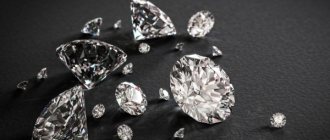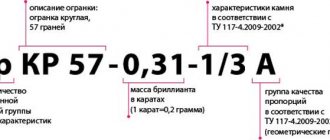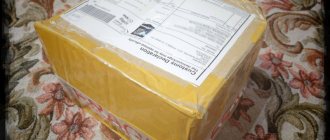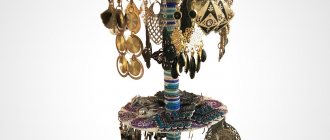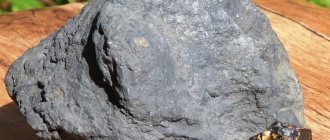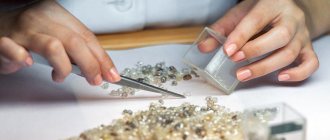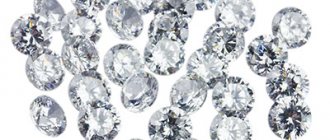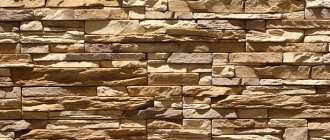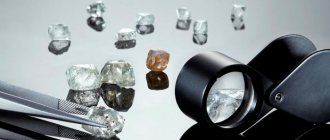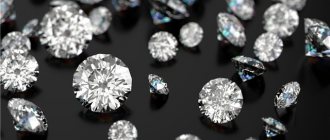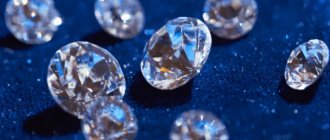October 18, 2022 The carat value of diamonds is a topic of long debate that is unlikely to subside in the coming years. The reason for this, no matter how trivial it may sound, is the high cost of the mineral. The retail price of a cut diamond is only growing, and unscrupulous sellers are constantly inventing new marking methods to hide the real mass of inlays from the buyer. That is why, when choosing a diamond ring or any other product, you need to know how much the stone weighs.
Now we will tell you how to determine how many carats are in a diamond, what calculation methods exist, and how accurate the generally accepted calculation systems are.
What is a carat of a diamond
Diamond is one of the most expensive precious stones. This is a cut diamond. The name means "sparkling". To add shine and convey the play of color, jewelers make many edges on the nugget, rounding the corners or leaving them sharp.
In classic jewelry, the top of the mineral looks like this after cutting:
- round;
- square;
- rectangular;
- oval;
- triangular.
The mass of a nugget is calculated in carats. The term comes from carato: the Italian name for the pod of the Ceratonia tree. The seeds of ceratonia fruits weigh 0.2 grams. This measure began to be used in antiquity, since there were no other ways to evaluate diamonds at that time.
The size of 1 carat diamonds differs according to the type of cut:
| Cut type | Number of faces | Width/length or diameter | Weight | ||
| mm (mm) | cm (cm) | Milligram | Gram | ||
| Round | 57(classical) | 6.4 | 0.64 | 200 | 0.2 |
| Square | 49, 57, 72 | 5.55 | 0.555 | ||
| Oval | 57 | 7.7/5.9 | 0.77 x 0.59 | ||
| Pear-shaped (drop-shaped) | 55, 56 | 5.8/8.6 | 0.58 x 0.86 | ||
| Heart-shaped | 57, 58 | 6.7/6.5 | 0.67 x 0.65 | ||
| “Marquise” (oval with pointed ends on the narrow side) | 55 | 5.6/9.8 | 0.56 x 0.98 | ||
| Emerald (rectangular) | 57, 65 | 6.4/4.9 | 0.64 x 0.49 | ||
| Equilateral triangle | 19–52 | 6.5/6.5 | 0.65 x 0.65 | ||
Carat is important in determining value. The least valued are crumbs (dust) and small cut diamonds up to 0.3 mm. The sparkle in them is barely noticeable. Large (from 1 ct) or medium (0.3–0.999 ct) nuggets cost 15 times more than the same weight of small-caliber minerals. Their sparkling shine (brilliantation) is clearly expressed.
In 1907, the value of 1 ct was officially approved - 200 milligrams. The International Metric Committee has established that the size of a diamond and other precious stones is indicated in this unit of weight, and other gems are indicated in grams.
Why are diamonds so expensive?
In general, your understanding of how the cost of diamonds is formed has already been formed - we just need to remind you of the main parameters. The price of these magical stones, enchanting with their shimmer, is partly the result of the skill of the jeweler, but the rest is literally a matter of luck: finding a pure diamond, putting skillful hands on it, showing it in the best light.
Large diamonds/high clarity/the right color/ideal cut – the chance is literally exceptional, such stones are incredibly rare and have an unrealistically high cost.
Stones that are more widespread are also not so cheap, but the reasons are the same: characteristics, or rather their combination. In addition, it is not easy to mine diamonds; deposits of high-quality stones are located at a depth of more than 300 meters, and most of them become suitable only for technical needs. There are not many diamonds worthy of cutting even for the general market.
Let's add to everything the exceptional strength of diamonds - this is the most durable, and therefore literally eternal stone, the highest rating on the Mohs hardness scale. And against the backdrop of such advantages, the advertising campaign for high-quality, expensive diamonds carried out on behalf of De Beers at the beginning of the last century does not seem to have had much of an impact on interest in the stones. How else can we explain the passion of monarchs, kings, and rulers of ancient times for diamonds?
How to determine how many carats are in a diamond (with table)
According to the standard, small round minerals have 17 faces. On medium-sized nuggets, it is possible to cut out 19, 24, 49, 55–57 sides. On large stones, the “royal” or “majestic” cut looks more advantageous. The first option has 74, 86 facets, and the second – 102. The shape affects the severity of sparkle and the size of the diamond in the product.
Table of the dependence of the mass of large diamonds on diameter:
| Round cut stone carat | Nugget size (mm) |
| 2.0 carats | 8.2 |
| 3.0 carats | 9.4 |
| 4.0 carats | 10.4 |
| 5.0 carat | 11 |
| 6ct | 11.7 |
| 7ct | 12.5 |
| 10ct | 14.1 |
| 14ct | 15 |
| 20ct | 17.8 |
| 30ct | 20.36 |
| 33.0 carats | 21 |
| 100ct | 30.5 |
The exact weight is determined only by weighing. Calculation formulas, including Tavernier's rules, give an error of up to 10%. The tables indicate the values taking into account compliance with cutting standards. The size of a 1 carat diamond in mm is 6.4. Medium caliber stones have D - less than 6.39 mm and below - 0.99 ct. A processed diamond of 0.5 carats corresponds to a diameter of 5.15 mm and a weight of 100 mg, while a 3 ct nugget has a diameter of 9.44 mm.
Determining the carat value of diamonds using the table is convenient when evaluating jewelry. Because of the setting, it is impossible to know the true weight of the stone. For measurements, use a caliper with an electronic display or a ruler with a mark of tenths of a millimeter.
Color
Colorless stones
Transparent stones are considered the most valuable. Colorless diamonds are divided into nine groups. The first group includes absolutely transparent stones, and the ninth group includes brownish or visible yellowish stones. Stones of groups 3–5 are considered popular. There is also a letter-based international classification, in which the color of stones is distributed from D to Z.
It is impossible to visually notice the difference between the stones of the third and fourth, as well as the fourth and fifth groups. At the same time, the difference in price is quite noticeable. Therefore, when the question is which diamond to choose, the decision depends on whether you are willing to overpay.
Colored stones
The cost of colored diamonds is affected by the brightness and saturation of the hue. Most often, colored options are cheaper than colorless ones, but there are exceptions. Thus, stones of the so-called fancy colors can be more expensive than the most transparent samples.
Weighing and calculating mass using Tavernier’s formula
The Tavernier principle is used to estimate the value of a cut diamond. To do this, weight is calculated in two ways. In the first, the mass is determined using the formula “diameter times height, times coefficient 0.0061.” Or compare in the size table how much 1 carat of round cut diamond weighs in grams.
Size chart:
| Diamond weight in carats depending on stone diameter | |
| Size in centimeters | Carat |
| 0.83 | 2.03 |
| 0.82 | 1.97 |
| 0.81 | 1.89 |
| 0.8 | 1.82 |
| 0.79 | 1.75 |
| 0.78 | 1.68 |
| 0.77 | 1.62 |
| 0.76 | 1.56 |
| 0.75 | 1.5 |
| 0.74 | 1.44 |
| 0.73 | 1.38 |
| 0.72 | 1.32 |
| 0.71 | 1.27 |
| 0.7 | 1.24 |
| 0.69 | 1.19 |
| 0.68 | 1.15 |
| 0.67 | 1.08 |
| 0.66 | 1.05 |
| 0.65 | 1.01 |
| 0.64 | 0.96 |
Next, the actual mass of the stone (the ratio of the diameter to the mass of 200 mg) is squared. The resulting figure is multiplied by the market value of 1 ct.
How to distinguish natural stone from synthetic
Artificially grown diamonds are similar in physical and optical characteristics to natural ones. They are almost completely identical, except that synthetic stones are created in laboratory conditions.
Experts will help you accurately determine the origin of a gemstone. It is also quite possible to independently verify the authenticity of a diamond: for this you will need an ultraviolet lamp. Under the influence of ultraviolet light, natural stones glow with a light blue hue. Synthetic counterparts will typically have a yellow or green cast.
Checking the weight for size
At home, you can check the carat value with a caliper and then compare the numbers using the size table. When comparing weight, you need to look at the type of cut. The diameter of a 1.0 ct round brilliant diamond is equivalent to 6.4 mm. A 2 mm nugget is equal to 0.013 ct. A size of 3 mm corresponds to a value of 0.043 ct, and a size of 4 mm corresponds to 0.08 ct.
If the cut is made out of proportion, the weight does not correspond to the standard in the table. This lowers the value of the nugget, although sellers may not lower the price.
Table of carat values of diamonds of different shapes
Suppose a stone of a popular cut is inserted into a gold jewelry. Each of them will have its own proportions, which means a different closing factor. There is no need to “draw” multi-story equations - everything has been calculated long ago, the results are listed in a table:
| Cut style | Aspect Ratio | Coefficient |
| Emerald or baguette | 1:1 | 0,008 |
| 2:1 | 0,01 | |
| Marquis | 1,5:1 | 0,0056 |
| 2:1 | 0,0058 | |
| Pear | 1,25:1 | 0,006 |
| 2:1 | 0,0057 |
Accordingly, in the formula, instead of the square of the diameter, the length and width along the largest sides are added. The calculation takes the form:
M = d*a*h*k
Instead of the letter k, all that remains is to substitute the value of the rightmost column. The aspect ratio is usually written on the certificate; if it is missing, do not hesitate to contact the seller.
What determines the price of a 1 carat diamond?
The evaluation takes into account transparency, color purity, and cutting accuracy. Deviation of at least one parameter from the standard reduces the value of the nugget. The price is also affected by the size of the diamond. After processing, it can have 1.0–1.999 ct or another carat value.
You can buy uncut chips of various shapes up to 300 microns (0.3 mm) in size for 35 euro cents/1 piece. A small nugget weighing 0.29 ct costs up to 50 thousand rubles. The price of medium cut minerals (0.3–0.99 ct) is in the range of 27,000–350,000 rubles.
Large diamonds weighing ≥ 1.0 ct are sold for at least 280 thousand rubles.
Purity
Before choosing jewelry or stones separately, consider not only the carat value, but also the clarity of the diamonds. The radiance of stones is determined by their ability to transmit light rays: the lower the purity index, the less pronounced their shine.
Absolutely pure stones without any inclusions are quite rare, which affects their cost. Such samples are often sold without frames, and they are subject to mandatory certification. To assess the clarity of diamonds, there is an international scale consisting of 11 levels: from IF - an absolutely pure stone, to I3 - a diamond with defects and inclusions.
The Russian classification provides:
· for small stones - 9 purity groups;
· for large ones - 12 purity groups.
Perfectly clear diamonds receive a 1, while those with noticeable and/or numerous inclusions receive a 12.
If your goal is to choose diamond jewelry for beauty and not for investment, take a closer look at diamonds that belong to groups 3–4 in color and 1–7 in clarity. As a rule, it is better not to purchase stones of levels 9–12 - due to numerous defects, they often split and do not look very attractive.
How many carats is the largest diamond in the world?
The largest mineral weighs 545.67 ct. Due to the brownish-yellow color of the diamond and the 50th anniversary of the reign of the King of Thailand, it is called the "Golden Jubilee". It has a cushion shape with rounded edges. Master Gabi Tolkowsky (from the Tolkowsky dynasty of jewelers) called the cushion cut of the nugget a fiery rose. There are 143 edges in total: 64 at the bottom, 55 at the top, 24 at the waist. The work took more than 23 months.
The carat measure is used when valuing precious minerals. Carat is indicated in ct, size – in mm. Nuggets of different cuts are the same in mass, but differ in size.
Watch an additional video review about carat content:
Comment on the article and share it on social networks, supplement the information with your experience and interesting facts. Best wishes.
Beautiful and affordable diamonds – photos
Most likely, you have noticed that diamonds that are not colorless have the highest artistic value. But in real, non-auction life, everything is quite the opposite and it is white stones that have no color, or at least with an indistinct tint, that are used in jewelry. And they are also beautiful and charming.
A good selection of jewelry with good quality diamonds is in our catalog. We are pleased to give all customers an additional 5% discount when purchasing any jewelry online, and also invite you to join auctions to reduce prices.
Cost of gemstones depending on weight
In addition to the purity of shine, transparency, cut, and number of facets, the price of diamonds is influenced by their weight. The heavier, the more expensive.
Diamonds are divided by carat:
- diamond chips - no more than 0.01;
- small – no more than 0.029;
- average – 0.03÷0.99;
- large – more than 1.
The cost depends on the type of diamond. It is worth noting that each type has different price categories and can vary tenfold. The price of 1 carat is different for each type; in large ones it will be much higher than in medium ones. The weight and clarity of large stones will differ, so the price for 1 carat will be different for each diamond. In other categories, the price difference also remains. This is the distinguishing feature of diamonds from gold, where the cost of 1 g is a constant value.
Buying large diamonds is a safe investment. They do not depreciate in value, they can be used to make jewelry that has no equal, they are easy to store and sell. During storage they do not lose their properties or sizes.
Small diamonds or chips are more common, so their cost is low. But, according to scientists’ forecasts, in the near future the deposits will close in 30-50 years, and their prices will rise sharply.
Whether or not to invest freely in the purchase of diamonds is a personal matter for everyone. You should study the market carefully before purchasing.
Diamond chips and small stones are not of great value. They are mainly used in various industrial sectors. Diamond coating increases the hardness and cutting properties of tools, cutters, etc.
Estimation using formula.
You can also calculate the approximate carats of a round diamond using the following formula:
Carat Weight = Diameter x Diameter x Depth x 0.006
The diameter of a round stone is the length of an imaginary line that passes through its center (when looking at the diamond from above) and connects two points located opposite each other on the girdle (at the edges).
Depth is defined as the distance from the top facet of the stone (table) to a point at the bottom of the diamond (if there is a facet there, it is called a “culet”).
For example, if you have a round diamond with a diameter of 6mm and a depth of 3.5mm, then its weight can be calculated as follows:
6 mm x 6 mm x 3.5 mm x 0.006 = 0.76 ct
This result is considered to be an estimate as the actual carat weight may vary by at least 5-10% in either direction i.e. the actual value may be from 0.70 to 0.80.
A diamond is not a stone for you: what minerals pass off as a cut diamond?
Diamond is the strongest gem. It cannot be scratched even with great effort. It can cut glass. Any master knows what diamond coating is. But not everyone is a diamond.
Diamonds are already processed (polished and faceted) diamonds. Only 25% of diamonds are suitable for the jewelry industry.
The cutting of the stone is designed to show all its natural beauty, which is expressed in the extreme play of light. It is thanks to her that the diamond glows from the inside. The spectacle is fascinating. It's a rare person who will refuse diamond jewelry. Women dream of such a gift, men spend fabulous money... There are so many people who want it that no natural reserves would be enough.
That's why diamonds are grown artificially. To make them more accessible, cubic zirconia and some other minerals are cut into diamonds. People are happy to buy them. But there is also another side to the coin. Sometimes cheap stones are passed off as real.
cubic zirconia
Often ordinary cubic zirconias are passed off as cut diamonds. Cubic zirconia is an artificially produced mineral, crystals of zirconium dioxide. It is curious that it was not created for jewelry at all.
The first cubic zirconia was grown in the USSR about 50 years ago. It was intended for use in lasers.
But very soon jewelers noticed the stone. Cubic zirconia has a diamond luster. Its refractive index is 2.15–2.25, which is very close to gemstones. At the same time, the price for it is more than affordable.
In the 90s, cubic zirconias were often passed off as diamonds. Today it is much more difficult to deceive buyers. Their hardness is only 7.5–8.5 on the Mohs scale, while the diamond index is 10. Cubic zirconias are scratched, often have microscopic chips, and become dull from chemicals. They are heavier than diamonds. And any tester can distinguish cubic zirconia right away.
Moissanite
Moissanite is a natural mineral, silicon carbide. It is considered the most expensive diamond substitute. In terms of its optical properties, it even surpasses the original - it plays 2.5 times stronger in the light. The mineral is rare, and its size does not exceed 2 mm.
Few people know that it is not natural moissanite that is inserted into jewelry, but its synthetic analogue, carborundum.
The mineral is slightly inferior to diamond in hardness. According to the Mohs scale, its indicator is 9.25. There is another distinctive feature - birefringence. The spike visible through the platform is double. But this is not easy to consider.
Not every gemologist and tester will be able to distinguish moissanite from a real diamond. The tester must be highly sensitive, and the specialist must be experienced.
Both stones have almost the same thermal conductivity, so inexpensive testers are fooled.
Rock crystal (quartz)
Quartz is one of the most common minerals in the earth's crust. Everyone knows such varieties of quartz as amethyst, citrine, aventurine, and rock crystal. It is rock crystal that is sometimes compared to diamonds.
In ancient Greece, it was believed that rock crystal was ice turned into stone. In jewelry, its variety is valued - Marmarosh diamonds. They are very transparent, clean, well formed, and are often inserted into jewelry without cutting.
Rock crystal is similar to diamond in its transparency and purity. But any professional can easily see the difference between them.
Just look at the photo:
Next to a diamond, rock crystal looks cloudy. Its edges are smooth. If you place a stone against printed text, you will be able to distinguish the letters. In addition, when examined through a magnifying glass, clusters of small bubbles can be detected in the crystal.
Rock crystal is rarely passed off as a diamond. This way they can try to deceive only an inexperienced buyer who buys jewelry second-hand.
Glass
Beautiful rhinestones are made from glass. They differ from acrylic rhinestones by the presence of a strong shine and a high refractive index of light. Sparkling in the sun or in the spotlight on clothes, they really resemble precious stones.
The quality of glass rhinestones depends on the lead, barium or zinc content. The most famous Swarovski rhinestones contain 32% lead oxide. The effect of the play of light is simply amazing. However, glass rhinestones are easily scratched. And they are simply not inserted into jewelry.
Glass is not used in jewelry.
Famous Swarovski rings and earrings contain cubic zirconia. They are the ones most often popularly called “glass.”
Basic properties of the stone
To identify a real diamond, you need to know its properties.
It is the hardest substance in the world, with a hardness of 10 Mohs units. Only a diamond can cut through the surface of a sapphire or ruby.
Hardness does not mean strength. A diamond can be split with a strong blow from a hammer - it will crumble like glass.
Although there will be a dent on the hammer after this.
This stone is the only monomer among all precious minerals, that is, it consists of only one substance - carbon. But it may include admixtures of substances that were naturally found in its vicinity.
A ring with a diamond
This is a transparent mineral that does not have the property of pleochroism - that is, it does not change color under any circumstances. Has high refractive indices. Diamond refracts light very strongly, and this property is used for self-testing.
A genuine stone has pronounced dispersion, that is, it “decomposes” the light beam into components along the spectrum.
This explains the play of light on the surface of the stone. However, due to strong refraction, there are no bright colors in the game. This stone does not glow with all the colors of the rainbow, it gives a soft silvery glow.
It has no birefringence.
It is characterized by luminescence - glow in ultraviolet, X-ray and cathode rays, and to a lesser extent in sunlight. This property is also used to determine the authenticity of a diamond.
Diamond has high thermal conductivity and heats up quickly.
If you try to set it on fire in air, it burns, turning into carbon dioxide.
Insoluble in acids except hydrofluoric acid.
The standard number of facets for a diamond is 57.
